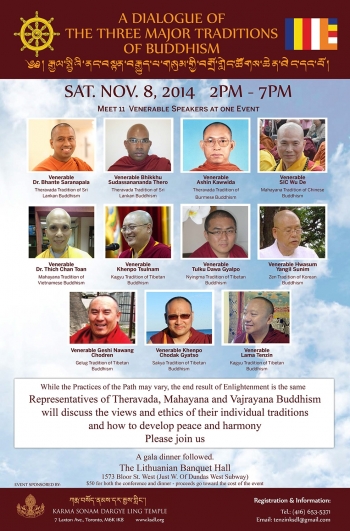 Poster for "A Dialogue of the Three Major Traditions of Buddhism." From Dorje Kirsten
Poster for "A Dialogue of the Three Major Traditions of Buddhism." From Dorje KirstenWhile all coming from the same source, Buddha Nature, the various traditions of Buddhism can vary dramatically in their presentations of practice and historical lineage. In all spiritual and philosophical traditions, the variations that arise out of the original teachings eventually become a source of strife between the different schools. As a collection of diverse traditions with a 2,400-year history of emphasizing different aspects of a single teacher’s vast methodologies, Buddhism has certainly been no exception to this tendency.
However, the different schools of Buddhism share at their core a great commonality of purpose—enlightenment—so it must be possible to gather all the schools together to elucidate their similarities. Toronto, a thriving melting pot of people, religions, social classes, and ideologies, turned out to be the perfect place for such a gathering last weekend. From all across the world, teachers from the Theravada, Mahayana, and Vajrayana traditions and their sub-schools traveled to Toronto to talk not about differences, but about the way that all three traditions derive from a single, infallible source. The event was sponsored by Karma Sonam Dargye Ling Temple, the Canadian seat of the Gyalwang Karmapa.
Although the gathering was short, with a formal presentation lasting a mere five hours and a banquet dinner, it was very extensive in its scope and vision. Attending from the Theravada tradition were: Venerable Dr. Bhante Saranapala, who is known as the “Urban Buddhist Monk” and is the Buddhist chaplain at the University of Toronto; Venerable Mankadawala Sudassana Thero, the chief meditation master of Labunoruwakanda Forest Monastery at Muriyakadawela, Galenbindunuweva, Sri Lanka; and Venerable Ashin Kawwida, from the Burmese Buddhist tradition.
The Mahayana tradition was represented by Venerable Sic Wu De of Taiwan, who is the 43rd successor of the Seven-Pagoda-Temple branch of the Linji School of Buddhism; Dr. Thich Chan Toan of Mahabodhi Society International, a school of Vietnamese Buddhism; and Venerable Hwasum Yangil Sunim, who represented the Seon (Zen) school of Korean Buddhism.
From the Vajrayana tradition were Venerable Khenpo Tsulnam and Venerable Lama Tenzin from Karma Sonam Dargye Ling Temple, representing the Kagyu tradition; Venerable Khenpo Chodak Gyatso, representing the Sakya tradition; and Geshe Nawang Chodren, for the Gelugpas; the Nyingma representative was the Venerable Tulku Dawa Gyalpo.
An interesting addition to the schools representing the Vajrayana tradition was Venerable Thom Kilts, representing the “Crazy Heart Lineage” of Celtic Buddhism, an American offshoot of Vajrayana Buddhism conceived by Chögyam Trungpa Rinpoche and Venerable Seonaidh Perks. This lineage unites the vision of Vajrayana with the historical mythology and heritage of people who claim Celtic ancestry or identify with its culture. The reach of Celtic Buddhism has now spread from Northern America to Ireland. They have opened a monastery called Glen Ard Abbey in Howland, Maine.
The definition of Celtic Buddhism appears to have intentionally been left vague. As founder Seonaidh Perks says: “It's still a big question mark as to what Celtic Buddhism is going to evolve into. It’s important to make the question mark very big, so that it remains a big open question. Not only about oneself, but the society in which one lives. Celtic Buddhism could be viewed as an open exploratory adventure with no conclusions.”
According to the event’s sponsor, the intention of the gathering was to invite representatives of the different vehicles to speak on the views and ethics of their individual traditions. The objective was to provide an opportunity for the audience to hear the essential similarity of all Buddhist traditions. While the practices of the path may vary, the end result of enlightenment is the same. This unity was the message of the symposium.















